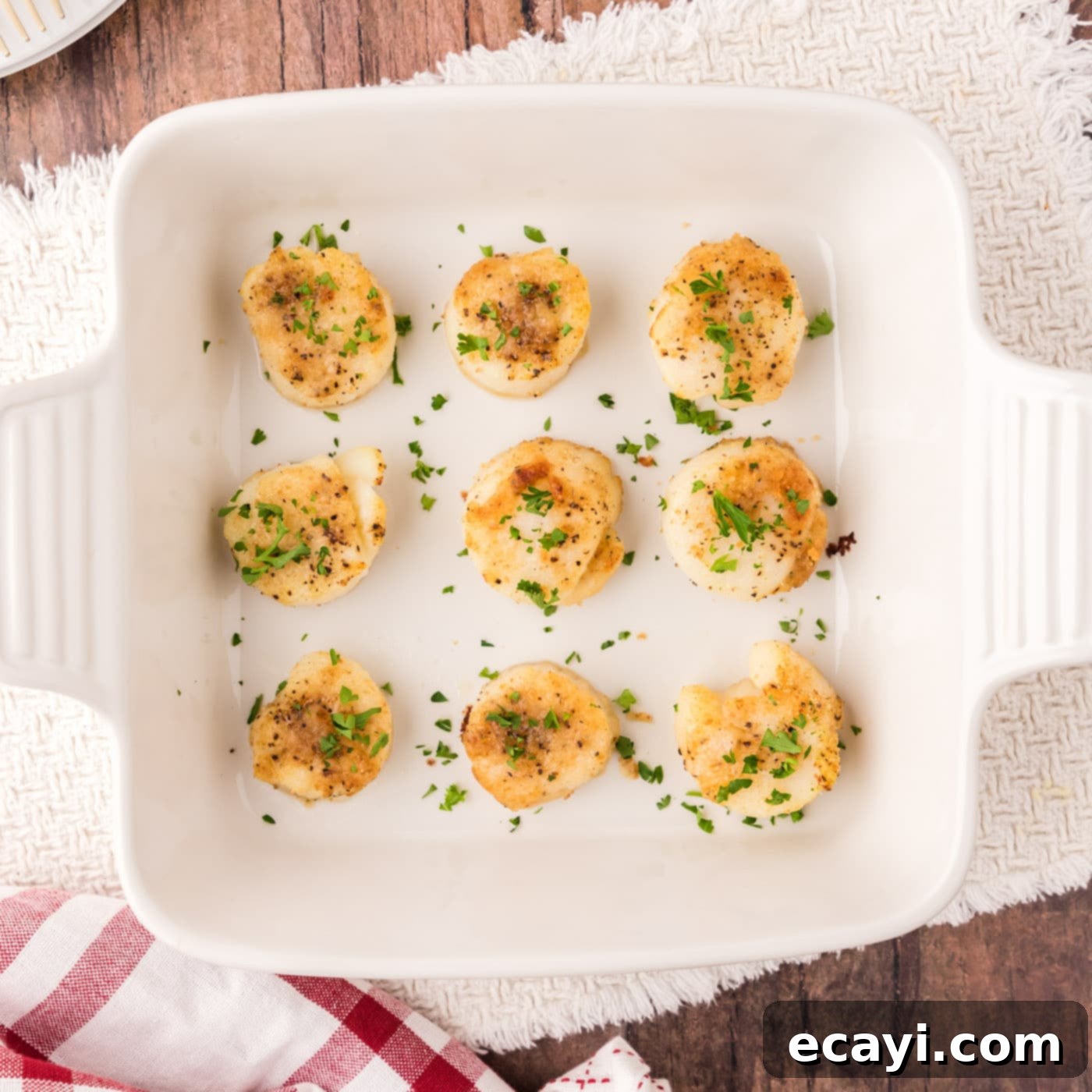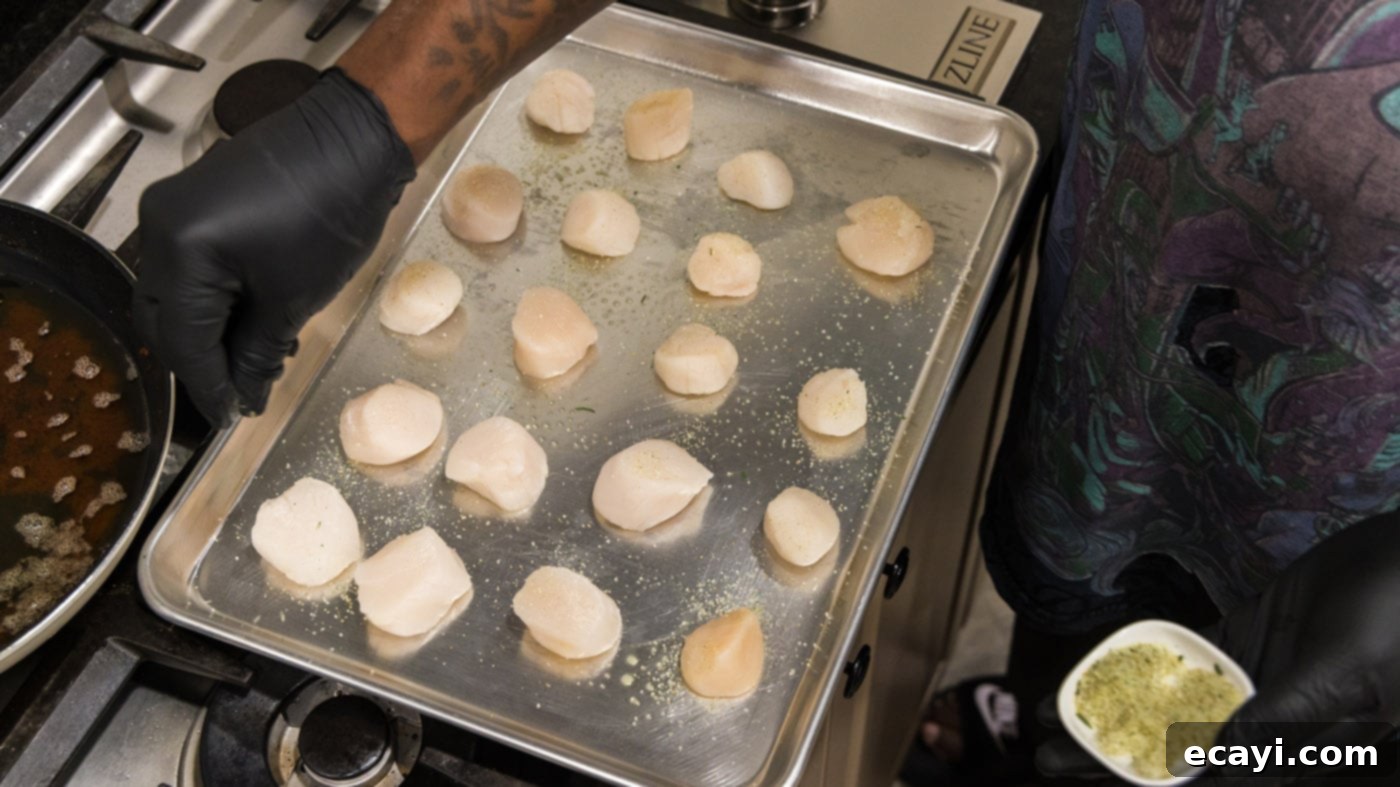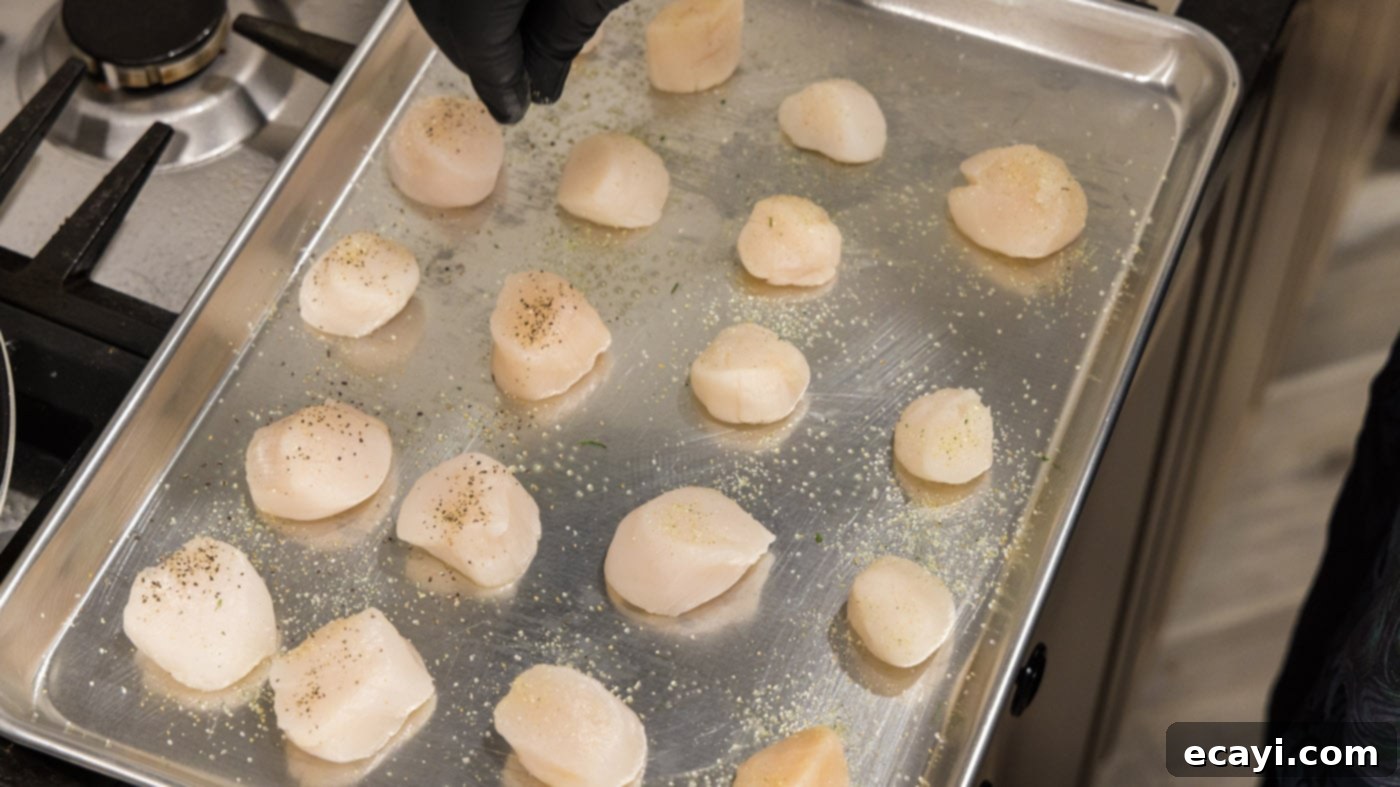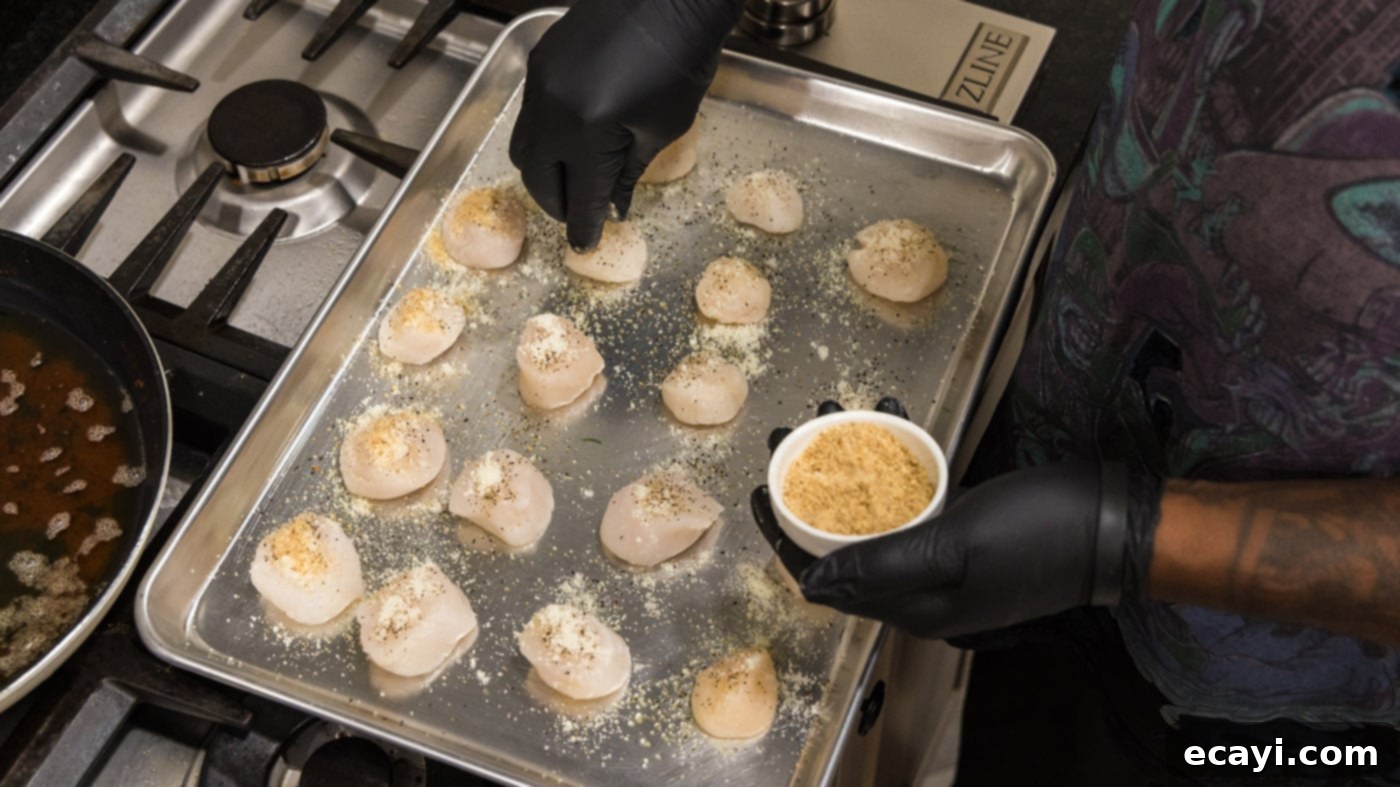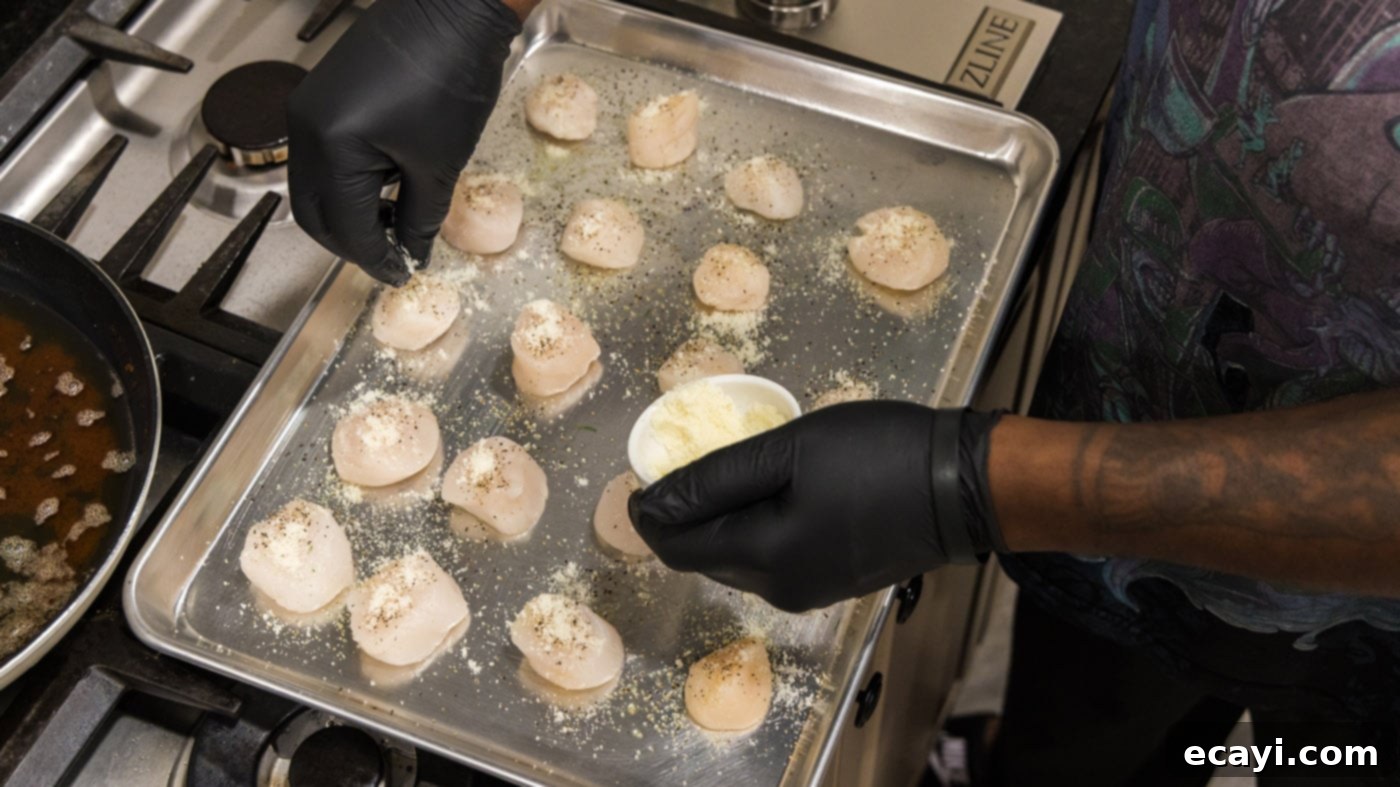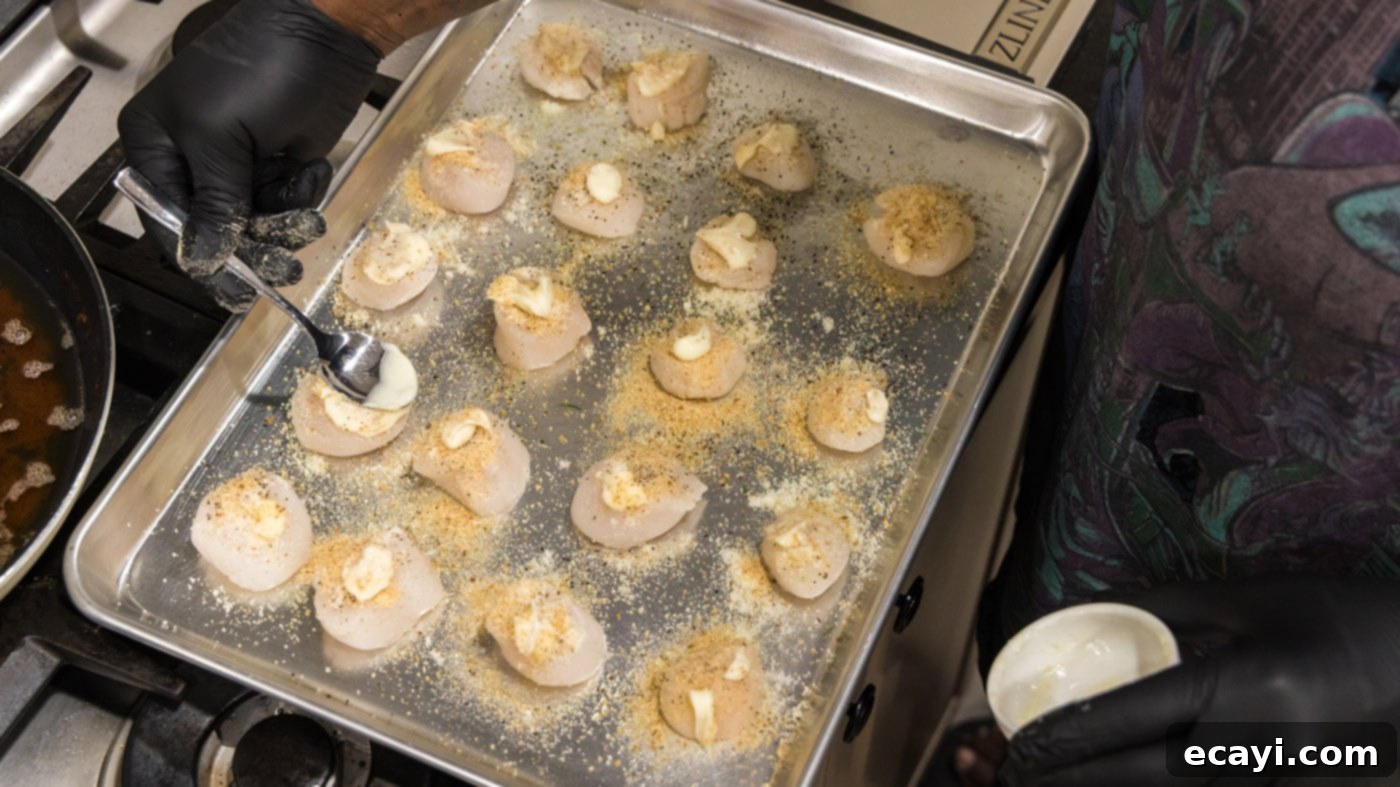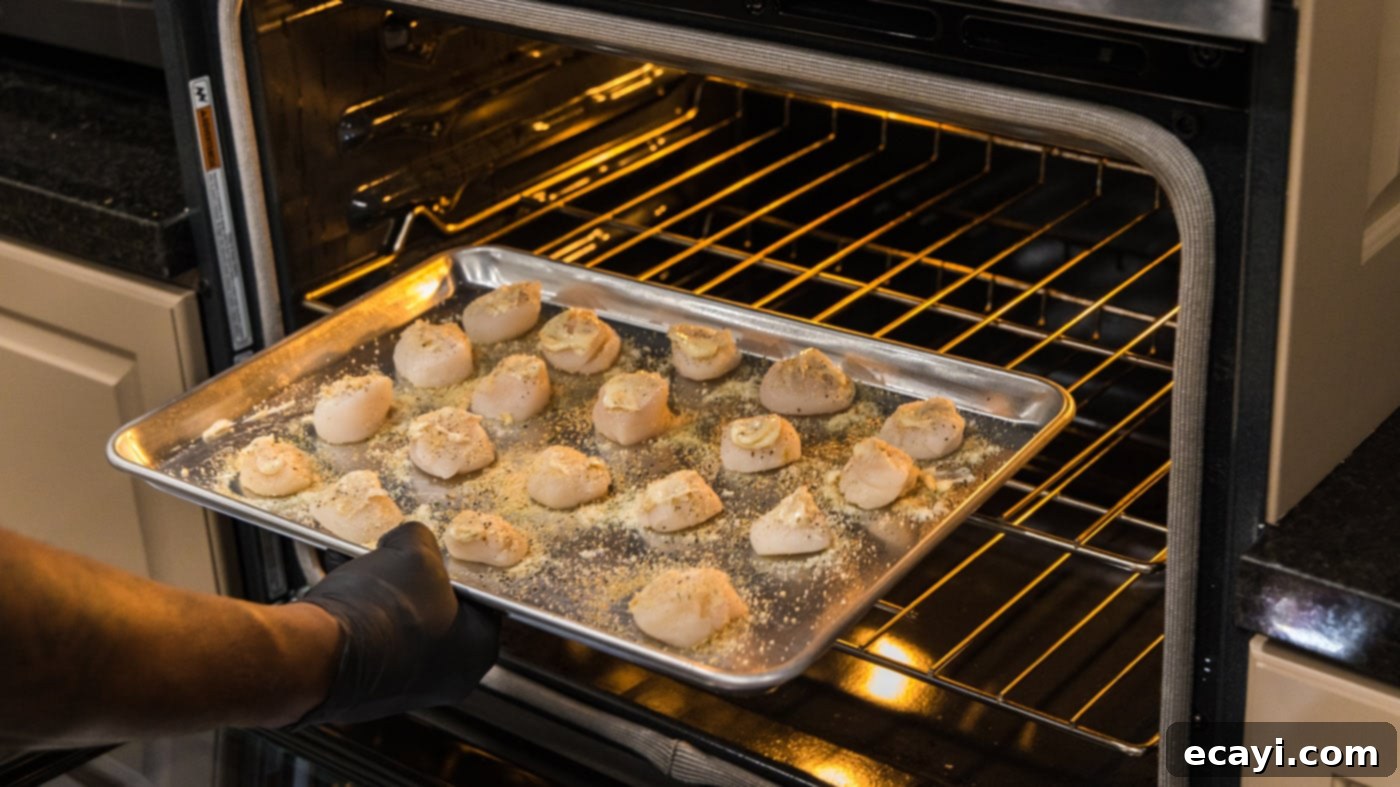Perfectly Baked Scallops with Golden Parmesan Crust: An Easy, Elegant Seafood Delight
Prepare to be amazed by these golden-crusted baked scallops, a dish that combines elegance with effortless preparation. Tender, sweet scallops are delicately seasoned, then crowned with a savory blend of breadcrumbs and Parmesan cheese. A final brush of melted butter ensures a beautiful golden finish and irresistible richness as they bake to perfection in just 12-15 minutes. This recipe elevates a simple ingredient into a show-stopping meal, perfect for a quick weeknight dinner or a sophisticated gathering.
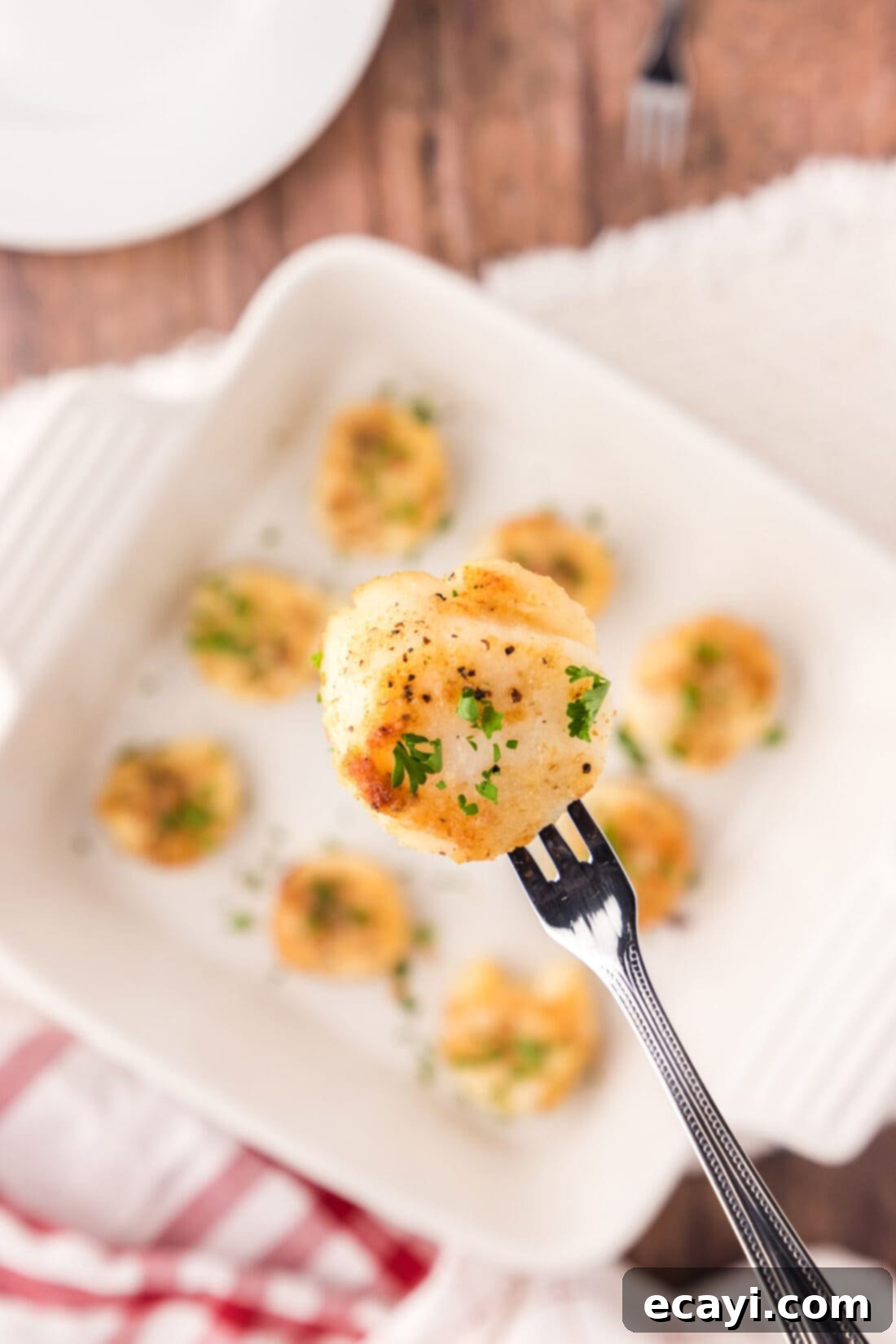
Why This Easy Baked Scallop Recipe is a Must-Try
Baked scallops are an absolute delight for any seafood enthusiast, and the beauty of this particular recipe lies in its sheer simplicity and incredible results. Forget the misconception that fancy seafood dishes are reserved for restaurants; these tender morsels are remarkably easy to prepare right in your own kitchen. Unlike other methods like pan-searing or frying, baking offers a hands-off approach that minimizes splatter and ensures even cooking. Each scallop is first seasoned with a simple yet effective combination of garlic salt and black pepper, enhancing its natural sweetness. Then, a light sprinkling of breadcrumbs and Parmesan cheese creates a delightful textural contrast, forming a delicate, crispy crust. Finally, a gentle brush of softened butter before they go into the oven guarantees a moist interior and that coveted golden-brown exterior. The entire process takes mere minutes of active preparation, allowing you to enjoy a gourmet-quality meal without the fuss or the hefty restaurant price tag. This recipe truly proves that elegance and ease can go hand-in-hand in your culinary adventures.
There’s a unique satisfaction in creating a dish that tastes expensive but costs a fraction of the price when made at home. This baked scallop recipe allows you to impress guests or treat yourself to a luxurious seafood experience without any intimidation. The oven does most of the work, consistently delivering perfectly cooked scallops that are moist, flavorful, and boasting a tantalizing golden crust. It’s a testament to how a few quality ingredients and a straightforward method can yield extraordinary results, making it a staple for anyone looking to expand their seafood repertoire.
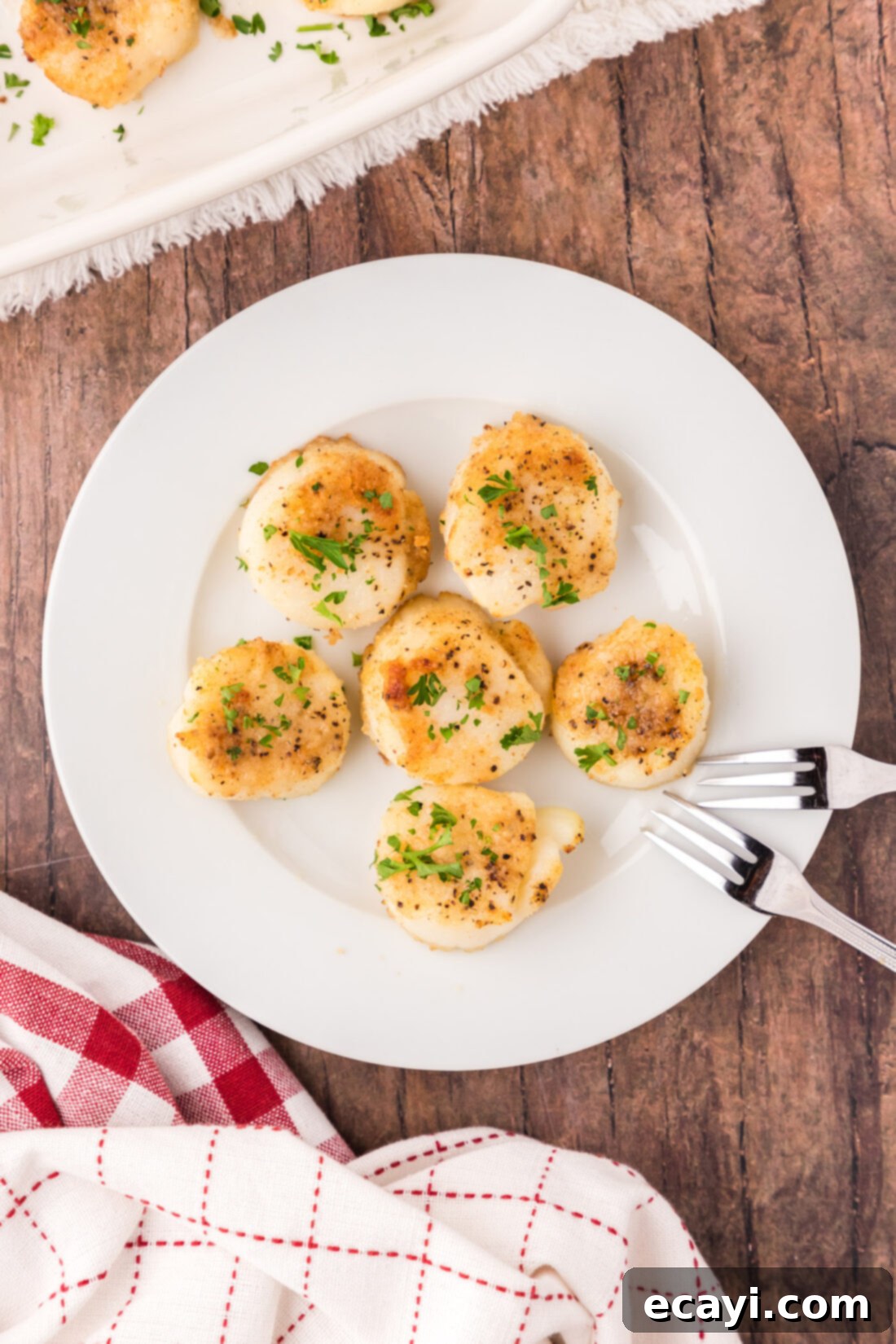
Essential Ingredients for Your Baked Scallops
Gathering your ingredients is the first step to creating this delectable dish. For precise measurements and detailed instructions, remember to check out the printable recipe card available at the conclusion of this article. This section provides a comprehensive look at what you’ll need and why each component is crucial for the perfect baked scallop experience.
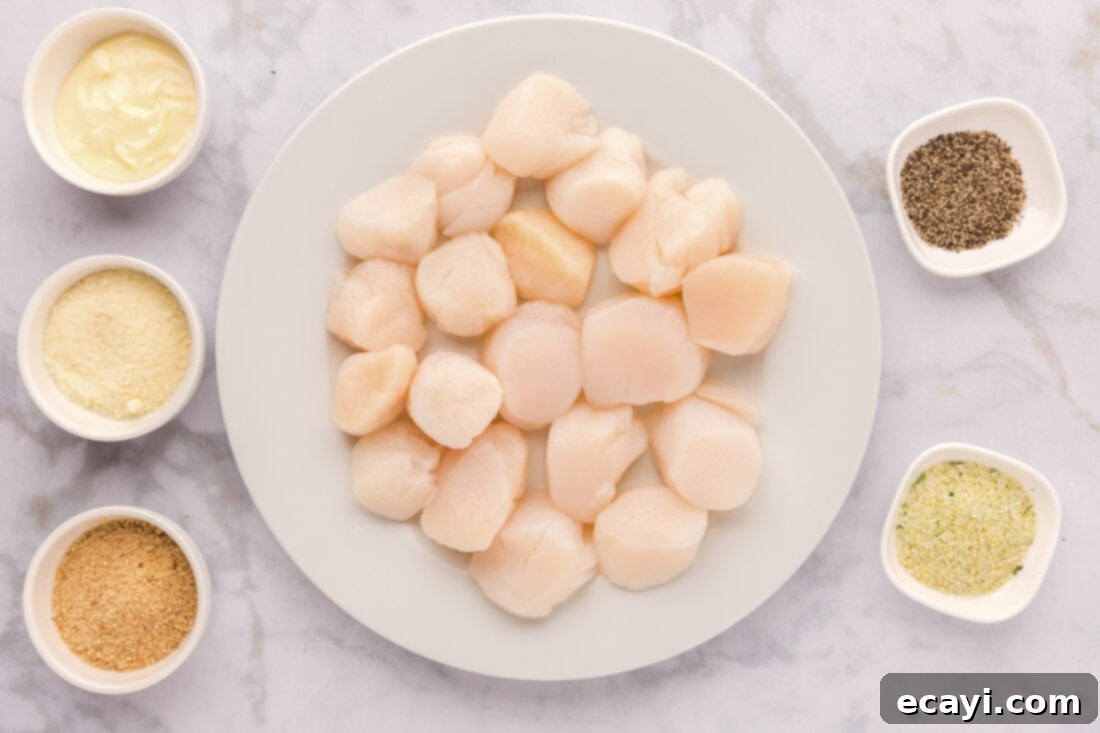
Ingredient Insights and Smart Substitutions
Understanding your ingredients is key to successful cooking. Here’s a deeper dive into the components of this baked scallop recipe, along with helpful tips and potential substitutions:
SCALLOPS – The star of our dish! You will want to purchase high-quality sea scallops for this recipe. Sea scallops are significantly larger and meatier than bay scallops, providing that satisfying bite and sweet flavor we’re aiming for. When shopping, you may encounter scallops labeled “wet” or “dry” at the grocery store. It’s important to know the difference:
- Wet Scallops: These scallops have been soaked in a solution of sodium tripolyphosphate (STP) to extend their shelf life and whiten their appearance. While this might seem beneficial, the STP causes the scallops to absorb and retain more moisture. When cooked, this excess water leeches out, preventing proper browning and resulting in a less flavorful, often rubbery texture. They can also shrink significantly.
- Dry Scallops: These are untreated scallops, meaning they haven’t been soaked in any solutions. They contain only their natural moisture. Dry scallops will caramelize beautifully when cooked, developing a rich golden crust and a tender, sweet interior. For this recipe, and indeed for most scallop preparations, we highly recommend using dry sea scallops for the best flavor and texture. If you can’t find them, make sure to thoroughly pat wet scallops dry before seasoning.
BLACK PEPPER & GARLIC SALT – These seasonings work wonders together. Garlic salt provides a convenient blend of salt and garlic flavor, which beautifully complements the sweetness of the scallops. Black pepper adds a subtle kick. You can adjust the amounts to your taste. If you only have regular salt and garlic powder, use a 1:1 ratio or slightly less salt, keeping in mind that garlic salt is less potent in pure garlic flavor than garlic powder. Freshly cracked black pepper is always preferred for superior aroma and taste.
BREAD CRUMBS – A crucial element for the golden crust! Standard plain breadcrumbs work perfectly, providing a delicate crunch. For an even crispier texture, you could opt for Panko breadcrumbs, which are lighter and flakier. If you’re looking for a gluten-free option, many brands offer gluten-free breadcrumbs that will work just as well. You could also experiment with seasoned breadcrumbs for an added layer of flavor, but be mindful of the salt content if doing so.
GRATED PARMESAN CHEESE – This adds a wonderful nutty, savory depth to the crust. Freshly grated Parmesan will melt beautifully and offer the best flavor, but pre-grated Parmesan is also suitable for convenience. Other hard, salty cheeses like Pecorino Romano could work as a substitute if you prefer a sharper taste, or even a blend of Italian cheeses for a more complex profile.
BUTTER – Softened butter is key here for both flavor and function. It helps bind the breadcrumb and cheese mixture, and as it melts in the oven, it creates that gorgeous golden crust and keeps the scallops moist. Ensure your butter is well softened – it should have a soft, puddling-like texture, making it easy to spread. If you’re dairy-free, a plant-based butter substitute can be used effectively. Unsalted butter is generally preferred so you can control the salt content with the garlic salt.
LEMON JUICE (Optional Garnish) – A squeeze of fresh lemon juice at the end brightens the entire dish, cutting through the richness of the butter and cheese and highlighting the scallops’ natural sweetness. It’s a simple addition that makes a big impact.
Mastering the Art of Baked Scallops: Step-by-Step Guide
These step-by-step photos and detailed instructions are provided to help you visualize each stage of making this delicious recipe. For a convenient printable version of this recipe, complete with precise measurements and full instructions, simply Jump to Recipe at the bottom of this post.
- **Prepare Your Oven and Baking Sheet:** Begin by preheating your oven to 400°F (200°C). While the oven heats up, prepare your baking sheet. Lightly spray it with a nonstick cooking spray to prevent the scallops from sticking and aid in easy cleanup. This step is crucial for achieving that perfect golden crust without worrying about adherence.
- **Arrange the Scallops:** Carefully place the scallops onto the prepared baking sheet. Ensure there is a little space between each scallop so they can bake evenly and develop a crispy exterior. Overcrowding the pan can lead to steaming rather than baking, which will prevent browning. If you’re using larger sea scallops, you might need two baking sheets to accommodate them properly. It’s also a good practice to pat the scallops thoroughly dry with paper towels before placing them on the sheet. This removes excess moisture, which is key for a good sear and a golden crust.
- **Season Generously:** Season each scallop evenly with garlic salt and black pepper. A light sprinkle on both sides will enhance their natural flavor without overpowering it. Don’t be shy, but also avoid over-salting, especially since the Parmesan cheese will also contribute salinity. Even distribution of seasonings ensures every bite is flavorful.


- **Add the Golden Topping:** Now for the glorious crust! Lightly top each seasoned scallop with breadcrumbs, followed by grated Parmesan cheese. Then, add a small dollop of softened butter on top of each scallop. Gently spread or flatten the butter a little to help cover the breadcrumb and cheese mixture. The butter will melt and integrate with the other toppings, creating a rich, flavorful, and beautifully golden crust as it bakes. This topping not only adds incredible texture and taste but also helps to seal in the scallops’ moisture.



- **Bake to Perfection:** Transfer the baking sheet to the preheated oven and bake uncovered for 12-15 minutes. The baking time can vary slightly depending on the size of your scallops and the calibration of your oven. Begin checking for doneness around the 12-minute mark. Scallops are ready when they turn opaque throughout and the topping is beautifully golden brown and crispy. Avoid overcooking, as this can make them rubbery. Remove them promptly from the oven once they reach the desired doneness.

Frequently Asked Questions & Expert Tips for Perfect Baked Scallops
While scallops are truly best enjoyed immediately after baking, you can store any leftovers in an airtight container in the refrigerator for up to two days. However, it’s crucial to note that scallops, being delicate seafood, spoil rather quickly. Reheating can sometimes alter their tender texture, making them a bit tougher. If you do reheat, do so gently in a preheated oven (around 275°F/135°C) until just warmed through, or a quick sauté in a pan, to avoid further cooking them.
Determining the perfect doneness for scallops is key to avoiding a rubbery texture. I always recommend checking the scallops for doneness around the 12-minute mark, as oven temperatures can vary significantly. Baked scallops are perfectly cooked when they become opaque throughout their center and the outside has developed a light, golden-brown crust. When you gently press down on a scallop, it should feel tender-firm, with a slight give, not overly squishy (undercooked) or completely firm with no give at all (overcooked). For precise results, aim for an internal temperature of around 115°F (46°C) on an instant-read thermometer when you remove them from the oven. Keep in mind that scallops, like most proteins, will continue to cook a few degrees (typically around 5-10°F or 3-5°C) from residual heat after being removed from the oven, reaching their optimal cooked temperature for serving. This is known as carryover cooking.
Yes, you can absolutely use frozen sea scallops. The most important step is to thaw them properly. Transfer frozen scallops to the refrigerator overnight. If you’re short on time, you can thaw them quickly by placing them in a sealed plastic bag and submerging the bag in a bowl of cold water for about 30-60 minutes. Once thawed, pat them extremely dry with paper towels before seasoning and baking. Excess moisture will prevent them from browning properly and can lead to a chewy texture.
The main secret to tender scallops is twofold: don’t overcook them and ensure they are dry before baking. Scallops cook very quickly, so precise timing and visual cues (opaque center, golden crust) are vital. As mentioned, an instant-read thermometer can be your best friend. Secondly, moisture is the enemy of browning and texture. Always pat your scallops thoroughly dry with paper towels before seasoning. This allows them to develop that desirable golden crust and ensures they cook evenly rather than steaming.
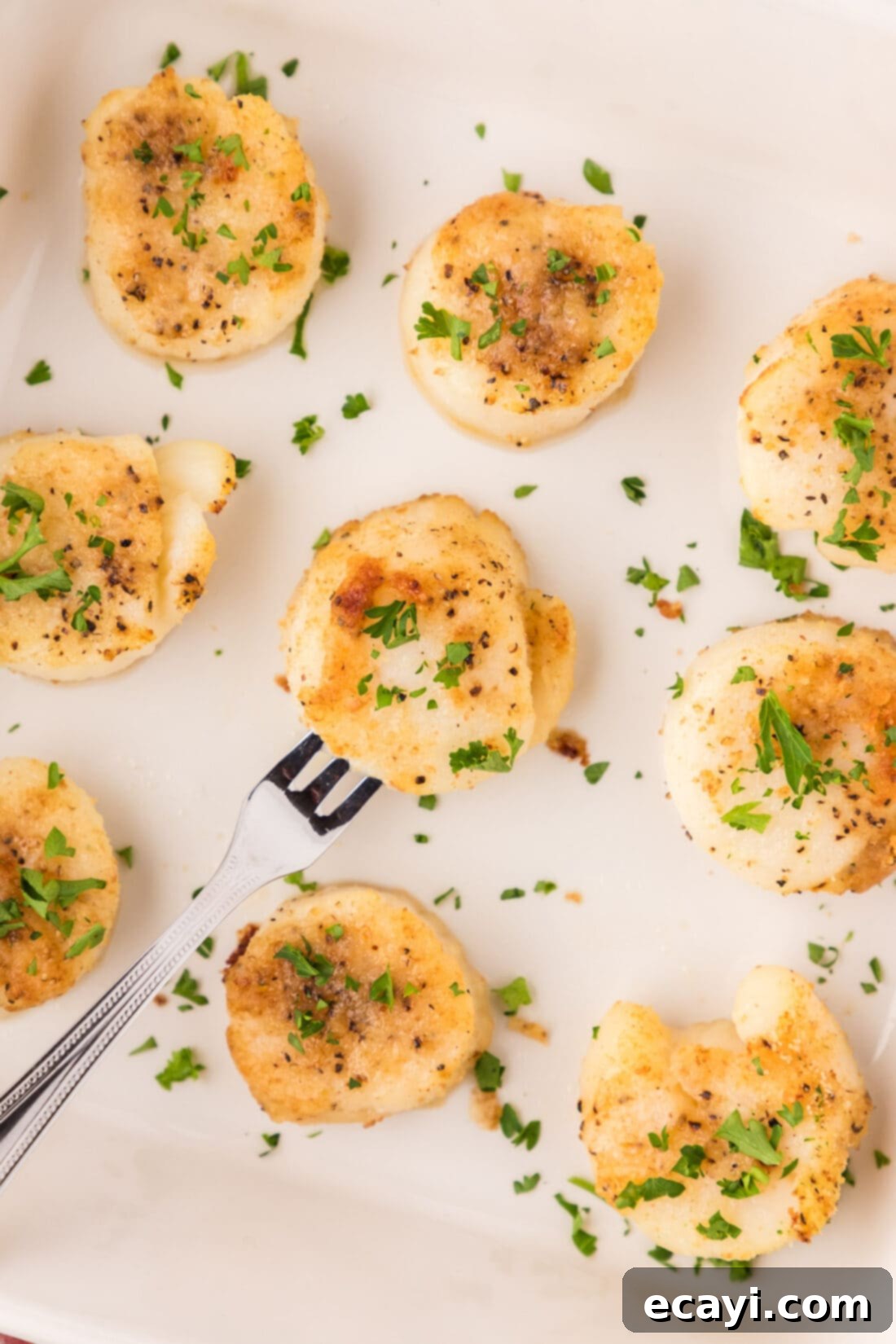
Elevate Your Meal: Inspired Serving Suggestions
These baked scallops are incredibly versatile and pair beautifully with a variety of side dishes, making them suitable for both casual and formal dining. For a light and healthy meal, serve them alongside vibrant green beans, tender asparagus, or sweet glazed carrots. If you’re looking for something more substantial, they are excellent with fluffy rice, a delicate pasta tossed in a light white wine sauce, or rich and creamy au gratin potatoes. Consider adding a simple lemon-butter sauce drizzled over the scallops for an extra layer of bright flavor, or a sprinkle of fresh chopped parsley for a pop of color and freshness. Don’t forget that optional squeeze of fresh lemon juice right before serving – it truly brightens the entire dish and enhances the scallops’ natural sweetness. For wine pairings, a crisp Sauvignon Blanc, a dry Pinot Grigio, or a light Chardonnay would complement the flavors beautifully.
Beyond these classic pairings, consider serving your baked scallops as part of a larger seafood platter, perhaps alongside grilled shrimp, crab cakes, or a fresh garden salad. They also make a fantastic appetizer when served with toothpicks or on small crostini. For a touch of elegance, you can even serve them in individual gratin dishes, keeping them warm and presenting them beautifully. No matter how you choose to serve them, these baked scallops are sure to be a hit!
Discover More Delectable Scallop Recipes
If you’ve fallen in love with scallops, there’s a whole world of delicious possibilities to explore! From crispy fried versions to savory pasta dishes, these recipes showcase the versatility and delightful flavor of scallops.
- Crispy Fried Scallops: For those who love a golden, crunchy exterior.
- Scallop Pasta: A luxurious and comforting dish combining tender scallops with your favorite pasta.
- Air Fryer Scallops: A quick and healthy way to get perfectly cooked scallops with minimal oil.
- Classic Pan-Seared Scallops: Achieve that beautiful restaurant-quality sear with this foolproof method.
- Bacon-Wrapped Scallops: The ultimate appetizer, combining smoky bacon with sweet scallops.
- Flavorful Grilled Scallops: Perfect for summer cookouts, offering a charred, smoky flavor.
I love to bake and cook and share my kitchen experience with all of you! Remembering to come back each day can be tough, that’s why I offer a convenient newsletter every time a new recipe posts. Simply subscribe and start receiving your free daily recipes, tips, and culinary inspiration!
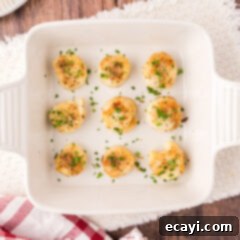
Baked Scallops Recipe
IMPORTANT – There are often Frequently Asked Questions within the blog post that you may find helpful. Simply scroll back up to read them!
Print It
Pin It
Rate It
Save ItSaved!
Ingredients
- 2 pounds large sea scallops preferably dry-packed
- 1 teaspoon black pepper
- 1 teaspoon garlic salt
- 2 Tablespoons bread crumbs or Panko
- 2 Tablespoons grated parmesan cheese
- 2 Tablespoons butter well softened. should have a soft puddling-like texture
- 2 Tablespoons lemon juice optional as garnish
Things You’ll Need
-
Baking sheet
-
Vinyl gloves
-
Instant-read thermometer
Before You Begin & Expert Tips
- When applying the breadcrumbs, Parmesan, and butter, the provided measurements ensure you have sufficient quantity. You don’t necessarily need to use every last bit if you’re satisfied with the coverage and seasoning on your scallops. Feel free to adjust based on the size and quantity of your scallops.
- For the best results, always purchase sea scallops for this recipe due to their larger size and sweeter flavor. Pay attention to whether they are labeled “wet” or “dry” at the grocery store. We strongly recommend using dry sea scallops as they haven’t been treated with preservatives, which means they contain less moisture and will caramelize beautifully, resulting in a superior texture and taste. If only wet scallops are available, ensure you pat them excessively dry with paper towels before seasoning.
- To achieve perfectly cooked scallops and avoid overcooking, I highly recommend checking for doneness starting at the 12-minute mark. Oven temperatures can vary significantly, even within the same kitchen. Baked scallops are done when their flesh turns opaque throughout, and the topping is golden brown and crispy. The texture should be tender-firm when gently pressed, offering a slight give. If they feel mushy, they are undercooked; if they are very firm with no give, they are likely overcooked and may be rubbery. For precise cooking, use an instant-read thermometer and aim for an internal temperature of around 115°F (46°C) when you remove them from the oven. They will continue to cook a few additional degrees (typically around 5-10°F or 3-5°C) from residual heat as they rest, reaching their ideal serving temperature.
- For an extra burst of freshness, consider sprinkling a tablespoon of finely chopped fresh parsley or chives over the scallops immediately after they come out of the oven.
Instructions
-
Preheat your oven to 400°F (200°C). Prepare a baking sheet by lightly spraying it with nonstick cooking spray to prevent sticking.
-
Arrange the sea scallops on the prepared baking sheet in a single layer, ensuring adequate space between each for even cooking. Pat them very dry with paper towels.
-
Season the scallops generously and evenly with garlic salt and black pepper on all sides.
-
Lightly top each seasoned scallop with bread crumbs, followed by grated Parmesan cheese. Then, place a small dollop of well-softened butter on top of each. Gently spread or flatten the butter slightly to cover the topping.
-
Bake the scallops uncovered in the preheated oven for 12-15 minutes, or until they are opaque throughout and the topping is golden brown and crispy. Use an instant-read thermometer if desired, aiming for 115°F (46°C). Serve immediately with an optional squeeze of fresh lemon juice.
Nutrition Information
The recipes on this blog are tested with a conventional gas oven and gas stovetop. It’s important to note that some ovens, especially as they age, can cook and bake inconsistently. Using an inexpensive oven thermometer can assure you that your oven is truly heating to the proper temperature. If you use a toaster oven or countertop oven, please keep in mind that they may not distribute heat the same as a conventional full sized oven and you may need to adjust your cooking/baking times. In the case of recipes made with a pressure cooker, air fryer, slow cooker, or other appliance, a link to the appliances we use is listed within each respective recipe. For baking recipes where measurements are given by weight, please note that results may not be the same if cups are used instead, and we can’t guarantee success with that method.
